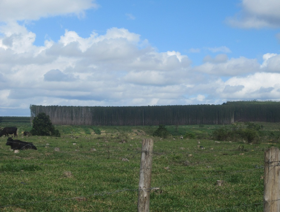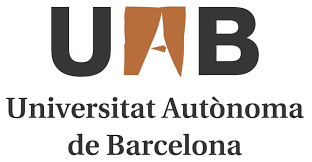
By Rikard Warlenius
We’re bumping on a sand road in Carlos’ trade union car. On the left side straight rows of 15-meter high eucalyptus trees are passing by. The plantation – calling it a forest would be a misuse of the word – extends for kilometres in both directions. You can see right into the plantation because there is no ground vegetation, no life besides the threes.
Meanwhile on the other side of the road we see maize, cassava, beans, bananas, potato and pineapple growing. Carlos points to the left and says “monoculture”, then to the right and says “diversity”. He repeats the movement and first says “for the corporations”, then “for the people”.
If you look closely into the plot of vegetables, you can see that there are stubs in exactly the same monotonous pattern as the trees on the other side of the road. This also used to be a eucalyptus field, until an early morning in March 2003, when families belonging to the landless people’s movement, Movimiento Sem Terra (MST), occupied the area. They cut the trees, constructed simple shacks of plastic sacks, moved in and started to cultivate the soil.
The landowner – the joint venture Veracel owned by the giant forestry companies Aracruz and Stora Enso – first threatened to spray pesticides on the occupiers unless they moved. But Brazil was in a new political situation. Lula da Silva of the Workers Party (PT) had recently been elected president on the promise of improving the lives of the poor. The occupiers soon got land rights for a permanent settlement not far away, and they named it after Lula.
Thousands and thousands of landless people are still fighting for land in Brazil, but here every family now has a small brick house and 3.4 hectares of land. They also share a common for coffee plantation and livestock. Above that, half the area of the settlement consists of Mata Atlantica, a rainforest biotope with richer biodiversity than even the Amazon. Not such a long time ago it covered most of the area. Today only fractions remain.
We continue our bumpy ride in Carlos’ car into the intense greenery of the forest. Where a small pawn is opening a hole in the green wall, we park the car and enter. After only a few meter we cannot longer feel the burning sun – our host Winnie Overbeek of the World Rainforest Movement (WRM) calls it ”natural air-condition”. Birds are singing, mosquito’s buzz and a centipede plays in the sand by the side of a stream. Ivonette, an environmental and social activist in the area, of partly indigenous ancestry, tells us about her almost physical need of finding peace in the forest in times of intense struggle.
This forest could of course be turned into more crop- and grazing land, but the poor farmers in the Lula settlement have decided to let it be, which is exactly the opposite of what Veracel and other forest companies did when they arrived in the area 20 years ago: there is many proofs of how large areas of primary rainforest – illegally – was cut down in order to make room for the eucalyptus plantations.
But that is not the only problem. The eucalyptus use so much water that surrounding agriculture often suffers from ground water depletion. And, they witness, Veracel uses so much pesticides that the fishes die. And there are social problems. When landowners sell their farms to Veracel the rural workers get unemployed and are driven into the cities where the crowds, poverty and violence increase. Furthermore, the excessive buyout of land for plantations diminishes the possibility for small-scale agriculture, which produces nearly 70% of the food consumed in Brazil.
The week after our study the Earth Summit in Rio, 1000 kilometre further south, started. The land conflict in the Extreme South of Bahia mirrors what was at stake there, but also on a global scale. Is land a right for those who need to provide food for themselves and their families, or a commodity to utilize freely for those who can pay the most? Unfortunately, the Rio summit was a step in the latter direction. But that is another story.
This field trip for Ejolt partners took place the 8th to 10th June 2012 and was organized by World Rainforest Movement and Cepedes. Besides visiting the MST camp and settlements, also occupations by a group of indigenous Pataxó peoples and another landless people, the moviemento de luta pela terra (MLT) were visited. Participants were Andreas Mayer (IFF), Serah Munguti (Nature Kenya), Leah Temper (UAB) and Rikard Warlenius (Lund University).
For more information, see the ITP plantations report





The impressions that we have gained on the local impacts of eucalyptus
plantations in Bahia are embedded in the wider policy framework in
Brazil which supports large scale monoculture instead of subsistence
agriculture. The land reform is going on very slowly, and the land
distribution still remains extremely unequal. There cannot be seen much
will of the Lula government to push through the land reform, and the
negotiations that leaded to the creation of Lulão, the settlement that
we have visited, were partly a result of massive protests and
occupations during the opening of Veracel’s first pulp mill. To
conclude, (even though there is progress of the land reform during the
government headed by Fernando Henrique Cardoso)) Lula´s generous
contributions to companies such as Veracel and other plantation
companies have facilitated a firm expansion trend in plantations and
cellulose production in Brazil since.
HOWEVER STILL NO SIGNIFICANT PROGRESS
IN LAND REFORM CAN BE SEEN, ALSO NOT NOWADAYS UNDER PRESIDENT DILMA FROM THE
SAME WORKERS PARTY AS LULA, IF COMPARED WITH THE FORMER GOVERNMENT OF
FERNANDO HENRIQUE CARDOSO. THEREFORE LAND STRUGGLES AS MST AND MLT CARRY OUT
CONTINUE NECESSARY TO PUT PRESSURE ON THE GOVERNMENT FOR LAND REFORM.